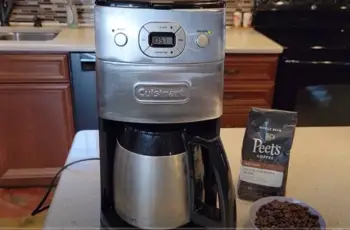A Mr. Coffee Iced Tea Maker can be used to brew both iced tea or iced coffee. Like a traditional drip coffee maker, this iced tea device brews the tea or coffee hot by pumping heated water over a steeping basket that holds tea bags or coffee grounds. It also may develop mineral deposits over time, much like a coffee maker. Most parts of the tea maker can be washed by hand, while mineral deposits in any part of the appliance require a vinegar treatment.
If you own a Mr. Coffee, you know that it is as reliable as a pair of Levi jeans. It is designed to serve you for years to come. However, even good-quality electronics do have their moments. And dealing with a malfunctioning coffee maker is not an ideal way to start your morning. With this guide, you can handle any of your coffee maker issues and learn how to use some of its convenient features.
How To Clean A Mr. Coffee Tea Maker
Cleaning Mr. Coffee Iced Tea Maker
Standard cleaning of the Mr. Coffee Iced Tea Maker requires hand washing, as the individual portions of the appliance are not dishwasher safe. Wash the pitcher and lid, as well as the steeping basket and its lid, in warm, soapy water, then rinse them off. These items may be washed after each use of the iced tea maker. They should also be washed before using the appliance the first time.
Rinsing the Main Unit
Once the hand-washable parts are clean, fill the pitcher with water up to the “water level” line. Pour the pitcher of water into the reservoir in the plug-in portion of the iced tea maker. Add ice to the pitcher up to the “ice” line, then place the steeping basket and its lid atop the pitcher. Push the pitcher up into place against the iced tea maker, plug the device in and turn it on. Once the water finishes flowing through to the pitcher, the cleaning process has been completed. Dump the water into the sink.
Removing Mineral Deposits from Pitcher
If your iced tea maker’s pitcher or brew basket has white, chalky marks on them even after washing, these spots are mineral deposits left behind by tap water. These spots, though unsightly, are harmless. Get rid of them by wiping them down with white vinegar applied with a clean sponge or paper towels. According to Mr. Coffee’s instructions, for stubborn mineral deposits, soak the affected pieces in white vinegar for 20 to 30 minutes, then rinse.
Removing Limescale from Main Unit
If your iced tea maker sputters or no longer functions as well as it should, there may be a mineral, or limescale, buildup inside the main unit. Pour a full quart-sized bottle of white vinegar into the water reservoir, then place a handful of ice cubes in the pitcher. Set the steeping basket and its lid atop the pitcher, push the pitcher against the base unit, then turn the unit on.
Once approximately 1 cup of vinegar brews through to the pitcher, unplug the iced tea maker and allow it to sit for 30 minutes or so. This allows time for the vinegar to remove limescale throughout the device. Plug the device back in, turn it on and wait for it to dispense all of the vinegar into the pitcher. Dump the vinegar down the drain, then repeat the brewing process once or twice, using tap water instead of vinegar. The tea maker is ready to use again once the dispensed hot water no longer smells like vinegar.
How To Fix A Mr. Coffee Maker
Step One: Check the Water Reservoir
There is no coffee without water. If your coffee maker turns on but won’t brew, first check the water reservoir. You can check the water level by lifting the lid or looking at the gauge on the side. Add water until full.
Step Two: Ensure All Parts Are in Their Proper Place
Coffee makers are sensitive machines, so check that all components are in good working order. Make sure that the filter is centered and supported. If the filter is broken or warped, replace it with a new filter. Secure the lid. Double-check the power settings.
Step Three: Clear Any Clogged Lines
More often than not, clogged lines are to blame for a faulty coffee maker. Some Mr. Coffee models have a blinking light to indicate your machine is due for regular cleaning. Even if your machine is new, it doesn’t hurt to submit it to a thorough cleaning. Fill the glass coffee pot with vinegar. Hold start for 2-3 minutes. Once the machine is heated, pour the solution through the coffee maker. Repeat as desired and rinse with water.
Step Four: Check the Heating Element and Fuses
If the problem persists, it’s time to check the fuses on the bottom of your machine. First, unplug your coffee maker and empty the water reservoir. Then, remove the plastic cover from the bottom of your appliance. The metal plate that you see is the heating element. The heating element connects to the U-shaped hose, which feeds from the water reservoir.
The thermal fuses– which look like long needles– should connect following the wiring on the bottom. Check for continuity. If one of the thermal fuses becomes displaced, the heating element will lose power.
Fortunately, you can find a thermal fuse at your local hardware store for less than $2. Using the accompanying sleeves, attach the new thermal fuse with pliers or a soldering tool. The point is to establish continuity. There should be no break in the lines on the bottom of your coffee maker.
Step Five: Contact Mr. Coffee for Replacements and Repairs
Mr. Coffee states that their products contain no user-serviceable parts. If you cannot resolve the issue by the above-mentioned, only a certified technician should attempt to repair the machine.
For Repairs: Mr. Coffee has several authorized service repair centers listed here. They service a wide range of Mr. Coffee products, from Espresso machines to coffee accessories. And the classic drip coffee maker, of course.
For Replacements: To take advantage of your 1-year warranty, file a claim at MrCoffee.com. All you have to do is upload a picture of your coffee maker and any faulty components. Include any helpful information such as the model number and date purchased.
Final Thoughts
Well, Mr. Coffee’s spray head is pretty sloppy. It’s just an open tube (sometimes multiple smaller holes) positioned over the coffee, with water periodically spurting out of it like ocean waves over rocks. On its own, rather than sending water evenly through your coffee grounds, Mr. Coffee’s brew water will dribble out of its spout and drip through via the path of least resistance. Most of the time, this means that the water will brew one side of the bed of grounds, and barely wet the other side. This unevenness is exacerbated when you’re using coffee roasted within the past month or so, because the CO2 gas expelled from fresh coffee when it’s met by hot water pushes outward, and the bubbly damp grounds form a barrier and push aside the dry grounds, effectively protecting them from the brewing water.
The easiest way to overcome this problem is to periodically open Mr. Coffee’s lid and with a spoon or other utensil, gently stir the coffee grounds to wet the entire bed of grounds and encourage evenness. Once everything’s saturated with water, osmosis and diffusion forces can kick in, working to help pull the flavor molecules out of the entire bed of coffee. Coffee brewing is like a hot-tub party for the coffee grounds. If you’re not wet, you’re not part of the party!


